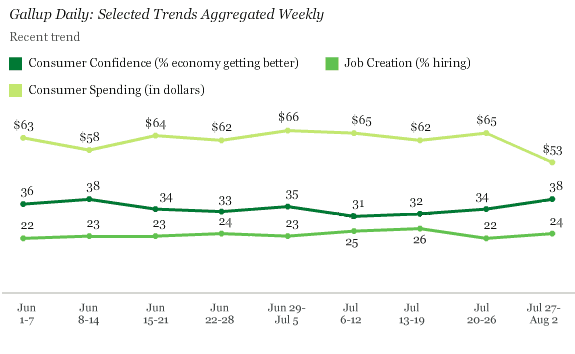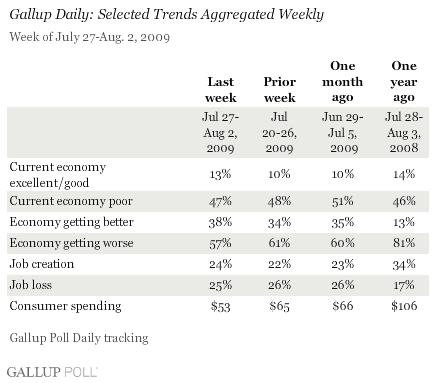PRINCETON, NJ -- Gallup's Consumer Confidence measure is up four points in the last week, with 38% of Americans saying the economy is "getting better." Despite the surge in confidence, Americans' self-reported daily spending is down 19% from the prior week and 50% from the same week a year ago. Meantime, job creation picked up a little, with 24% of employees saying their companies are hiring, but it remains down from the prior week.

Spending Remains the Major Problem
Americans' views of the current economy improved during the week ending Aug. 2, with a three-point increase in the percentage of Americans rating the economy excellent or good and a four-point improvement in those saying the economy is "getting better." The percentage "getting better" is slightly improved compared to a month ago and much higher than a year ago, and includes a 41% getting better score in July 31-Aug. 2 polling -- tied for the best Gallup has measured since the beginning of 2008.
Job creation improved two points while job loss eased one point during the most recent week, suggesting job-market conditions improved compared to the prior week and prior month but remain far worse than conditions a year ago.
Even as consumer confidence improved, consumers reported spending an average of $53 per day in stores, restaurants, gas stations, and online last week. This is down 19% from the previous week and about the same amount from the previous month, and down 50% from the same week a year ago. At least to this point, the soaring equities markets and the related improvements in consumer confidence have not translated into improved consumer spending on a day-to-day basis.

Commentary
Wall Street continues to celebrate with its best July since 1997 and the S&P's first closing above 1,000 since last November. Auto dealers and auto companies enjoy sharply higher sales as a government stimulus effort ("cash for clunkers") finally got consumers into the showroom. Still, even as consumer confidence improved, consumer spending behavior declined, suggesting Main Street has missed the party -- at least, to this point.
A similar increase in consumer confidence took place earlier this year after the March low in the equities market, but consumer spending remained essentially flat throughout the first half of 2009. While the surging stock market can produce something of a wealth effect for upper-income consumers, the spending "new normal" may offset those benefits to a major extent. In turn, the continued weakness in consumer spending further emphasizes the need for a significant improvement in the jobs picture.
On Thursday, the government will report jobless claims. Although jobless claims were distorted for much of July due to the auto bailout and change in the timing of plant closings, this measure should be settling down and providing better insight into the future direction of the job market. In this regard, Gallup's job-market measures suggest claims will remain in the high 500,000 range this week -- better than the mid-600,000 of earlier weeks but still indicating major job losses.
Further, July's unemployment rate -- to be reported Friday -- is likely to increase to 9.7% or more. A gloomy jobs report could easily erase some of the recent gains in consumer confidence seen over the past week. It might even moderate the euphoria on Wall Street. Regardless, it is hard to see how Main Street spending will match the mood on Wall Street until jobless claims and the unemployment rate improve significantly.
Survey Methods
For Gallup Poll Daily tracking, Gallup interviews approximately 1,000 national adults, aged 18 and older, each day. The Gallup consumer perceptions of the economy and consumer spending results are based on random half-samples of approximately 500 national adults, aged 18 and older, each day. The Gallup job creation and job loss results are based on a random half sample of approximately 250 current full- and part-time employees each day. For the total samples of these surveys, one can say with 95% confidence that the maximum margin of sampling error is ±3 percentage points.
Interviews are conducted with respondents on land-line telephones (for respondents with a land-line telephone) and cellular phones (for respondents who are cell-phone only).
In addition to sampling error, question wording and practical difficulties in conducting surveys can introduce error or bias into the findings of public opinion polls.
